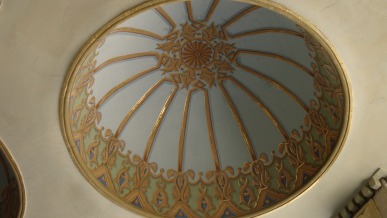“Governor”
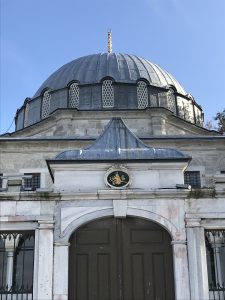 Just beyond Kuzguncuk on the Asian side of the Bosphorus, Beylerbeyi is a delightful, reclusive suburb mainly visited for its palace, the largest and finest of İstanbul’s secondary Ottoman palaces. The palace may be the main attraction but what makes a visit to Beylerbeyi especially delightful is that there is an entire hidden neighbourhood to explore as well. To find it you need to look out for a grand entrance on the main road that leads into the grounds of the huge Beylerbeyi Camii, built in 1778 by Sultan Abdülhamid I for his mother, Rania, and designed by Mehmed Tahir Ağa who was also responsible for the more familiar Laleli Cami.
Just beyond Kuzguncuk on the Asian side of the Bosphorus, Beylerbeyi is a delightful, reclusive suburb mainly visited for its palace, the largest and finest of İstanbul’s secondary Ottoman palaces. The palace may be the main attraction but what makes a visit to Beylerbeyi especially delightful is that there is an entire hidden neighbourhood to explore as well. To find it you need to look out for a grand entrance on the main road that leads into the grounds of the huge Beylerbeyi Camii, built in 1778 by Sultan Abdülhamid I for his mother, Rania, and designed by Mehmed Tahir Ağa who was also responsible for the more familiar Laleli Cami.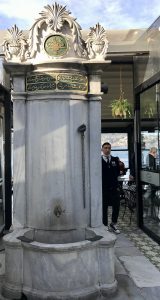
If you walk through the grounds and exit on the far side of the mosque you will find yourself in a lovely little square in front of the ferry terminal which is ringed with fish restaurants to suit all budgets and coffee shops to suit all tastes. Here, too, is the attractive Sultan Mahmud II Çeşmesi (fountain) dating back to 1811.
In 2024 much of the exterior of the palace was behind scaffolding for restoration.
Beylerbeyi Sarayı (Palace)
Beylerbeyi Palace (closed Mondays, admission TL350, Turks TL75, gardens only TL20) sits right beside the Bosphorus on the road out of Kuzguncuk to Çengelköy. It’s particularly easy to pick out if you take a cruise along the Bosphorus because it sits almost underneath the Bosphorus Bridge (the only bad news) and has a long landing-stage flanked by a pair of pretty bathing stations that look like Ottoman tents reconstructed in stone. Both have recently been restored and repainted although for the time being the public is not allowed inside them.
That waterside view is the one that would have greeted the sultans as they arrived at Beylerbeyi but modern visitors are not so lucky and have to be satisfied with approaching from the back, where the traffic-congested coast road runs right past the palace.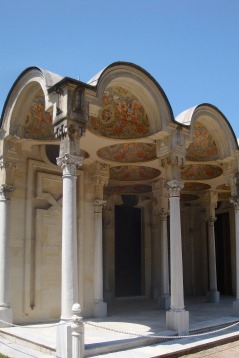
Beylerbeyi was the brainchild of Sultan Abdülaziz (r.1861-76) who commissioned Sarkis Balyan, the brother of Nikoğos Balyan who had designed Dolmabahçe, to take charge of the project. The new palace was built on the site of an older mansion that had burnt down and favoured the extravagant decorative style that appealed to the later sultans. Fortunately Beylerbeyi is more restrained, at least externally, than Dolmabahçe.
Like Dolmabahçe, it was also built as a single entity like the palaces of Western Europe. and unlike the old Topkapı Palace which was a collection of buildings in a variety of shapes and sizes that came together over the years to form a whole.
Beylerbeyi was mainly used as a grand guesthouse where such luminaries as Empress Eugenie of France were put up on state visits; the empress was purportedly so impressed by what she saw that she had copies of the palace windows made for installation in the Tuileries in Paris. Eventually, however, it became a gilded prison where Sultan Abdülhamid II was forced to live after his return from exile in Salonica in 1912 until his death in 1918.
Beylerbeyi has a fairly manageable 26 rooms but the single most breath-taking is the one on the ground floor that was designed with an enormous marble pool in the middle of it. Right in the centre is a lovely fountain surrounded by marble dolphins which meant that the sound of running water would have provided a constant backdrop on the hottest of sunny days, a wonderfully refreshing idea especially if you’ve just endured a sticky journey to get here by public transport.
Upstairs the two most impressive rooms gaze at each other across a central hallway. Both are decorated in Moorish style with lots of inlaid wood and mother-of-pearl.
Most of the other rooms are clones of Dolmabahçe, with plenty of heavy chandeliers, elaborate Yıldız porcelain, and carpets and drapery designed and made in the Hereke factory out on the Gulf of İzmit. What distinguishes the decoration at Beylerbeyi, though, is that most of the ceilings are decorated with delicate paintings of ships by the Polish artist Stanislas Chlebowski (1835-84) and that there are many large panels inscribed with poems and quotations from the Koran.
Once you’ve finished looking round the palace you can take a turn around the gardens, which contain the only stables to have survived from late Ottoman times as well as a couple of inviting pavilions, the Sarı (Yellow) and Mermer (Marble) Köşks. Also interesting is the tunnel carved beneath the terraces so that traffic could pass along the coast without intruding on the gardens.
The gardens have been undergoing extensive restoration for some time. Once the work is completed they will probably be magnificent.
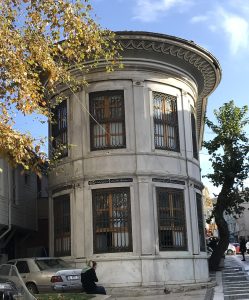
Sleeping
Bosphorus Palace Hotel. Tel: 0216-422 0003
Transport info
Coastal-hop ferries from Üsküdar stop at Beylerbeyi, saving you from the traffic jams on the coast road. Frequent buses in the 15 series also run along the coast road from Üsküdar to Beylerbeyi.
Deniz dolmuşes (sea taxis) run from Galataport to Beylerbeyi, stopping at Üsküdar and Kuzguncuk. They are quite pricy and only accept temassız (contactless) card payment – half-price if you use a Mastercard.
Nearby areas
